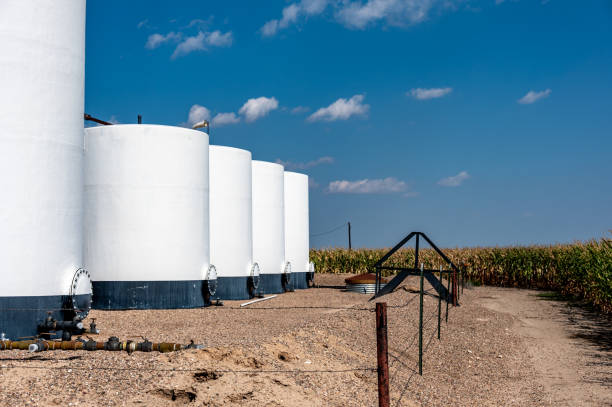The oil and gas industry faces some of the strictest environmental regulations in North America — and with good reason. From drilling and extraction sites to transport and storage terminals, the potential for hazardous liquid spills is significant. Industrial containment systems are the first line of defense against environmental damage, regulatory fines, and costly downtime.
If your business handles petroleum, diesel, lubricants, or other hazardous fluids, investing in proper spill containment solutions isn’t optional — it’s essential.
Understanding Industrial Containment Systems
An industrial containment system is any setup designed to catch and contain leaks, spills, or overflows of hazardous liquids before they can impact soil, water, or other assets. In oil and gas operations, this often includes:
- Secondary containment berms
- Portable spill berms
- Tank liners and ground liners
- Drive-over containment systems
- Custom containment platforms
These systems are engineered for durability, ease of deployment, and compliance with regulations like the EPA’s Spill Prevention, Control, and Countermeasure (SPCC) rule and similar Canadian environmental requirements.
Why Containment Is Critical for Oil and Gas Operations
In the energy sector, even a small leak can lead to:
- Contamination of water sources or land
- Shutdowns or operational delays
- Fines and lawsuits from environmental agencies
- Damage to company reputation
Spill containment systems help mitigate these risks by creating an added layer of protection beneath tanks, drums, trucks, and machinery. Whether your operation is remote, mobile, or stationary, secondary containment gives you peace of mind.
Applications in the Oil and Gas Sector
Oil and gas facilities use containment systems across a wide range of applications:
Drilling Sites
- Catch drilling fluids and produced water
- Line mud pits or temporary fluid storage zones
- Protect soil during hydraulic fracturing operations
Tank Storage
- Prevent leaks from above-ground storage tanks (ASTs)
- Use liners and berms to protect against tank base corrosion and seepage
Fueling Stations and Transfer Points
- Drive-over berms protect against transfer spills
- Portable containment mats for fueling heavy machinery in the field
Remote and Temporary Sites
- Portable and modular berms that can be deployed anywhere
- Foldable units for fast transport and setup in rugged environments
LLDPE Liners: Flexible, Durable Containment for Oil and Gas Sites
When it comes to lining your containment berms or tanks, LLDPE (Linear Low-Density Polyethylene) is the preferred choice in the oil and gas sector. Lighter and more flexible than HDPE, LLDPE liners offer:
- Exceptional chemical resistance
- Flexibility that conforms to uneven or irregular surfaces
- Reduced stress cracks and improved tear resistance
Because LLDPE conforms better to site-specific conditions, it significantly lowers the risk of liner failure due to shifting substrates or equipment pressure.
At The Containment Answer, our LLDPE liners are prefabricated in-shop and delivered ready to install — eliminating the need for any on-site welding. That means faster deployment, reduced labor, and fewer delays for oil and gas operations working in harsh or remote environments.
Woven Geotextile Fabrics: Structural Reinforcement Where It Matters Most
For oilfield applications where ground stability and load-bearing capacity are a concern — such as parking areas, temporary roads, or heavy equipment zones — woven geotextiles provide an added layer of structural reinforcement.
Made from high-tenacity polypropylene fibers, these woven geotextiles deliver:
- High tensile strength to support heavy loads
- Resistance to punctures and tear propagation
- Reinforcement for permanent or temporary installations
Though relatively impermeable and not intended for drainage, woven geotextiles excel at stabilizing soft ground, preventing rutting, and providing a base layer for containment systems or heavy machinery.
FAQ
What types of spills are industrial containment systems designed for?
Industrial containment systems are built to handle petroleum, diesel, crude oil, drilling fluids, fracking fluids, lubricants, and other hazardous liquids commonly found in oil and gas operations.
Are LLDPE liners safe for use in cold or extreme climates?
Yes. LLDPE liners are highly flexible and perform well in cold weather, making them ideal for oilfield containment systems used in Canadian winters or remote northern sites.
How long does it take to install a containment system at a well site?
Most prefabricated berms and LLDPE liners can be deployed in a matter of hours. The exact time depends on site conditions, size, and whether structural base work or geotextile reinforcement is required.
Can containment systems be relocated to different job sites?
Yes. Many of our portable spill berms, modular containment systems, and liner solutions are designed for field reuse, allowing for fast takedown and redeployment at multiple locations.
Do I need a geotextile fabric underneath my liner?
In most oil and gas applications, yes. A geotextile underlayer helps prevent punctures from rocks or debris and provides load support when used in conjunction with heavy equipment. It’s a best practice in remote or rugged terrain.
Are your containment systems certified for compliance with AER or EPA regulations?
Our containment products are manufactured to meet or exceed industry standards set by regulatory bodies including the Alberta Energy Regulator (AER), Environment and Climate Change Canada (ECCC), and the EPA in the U.S.

